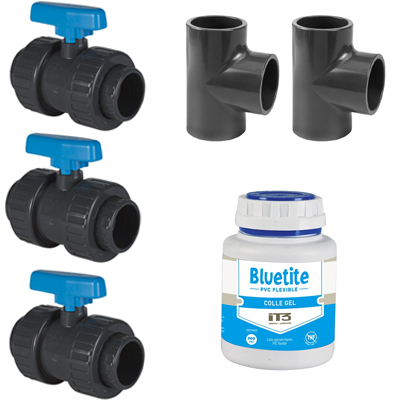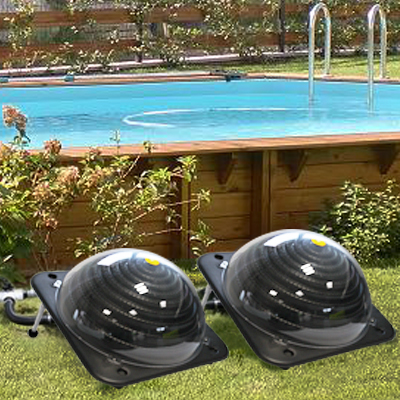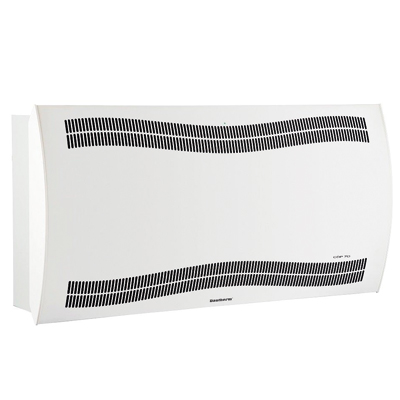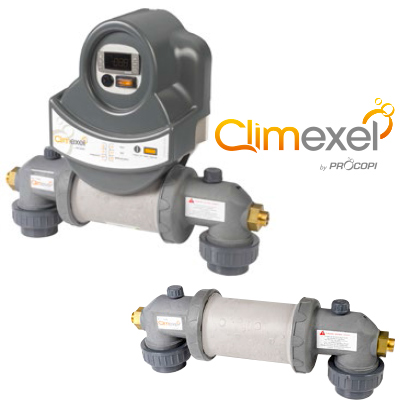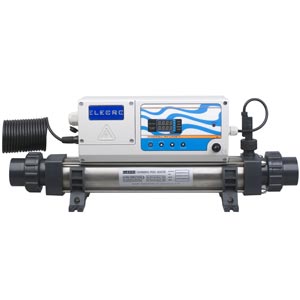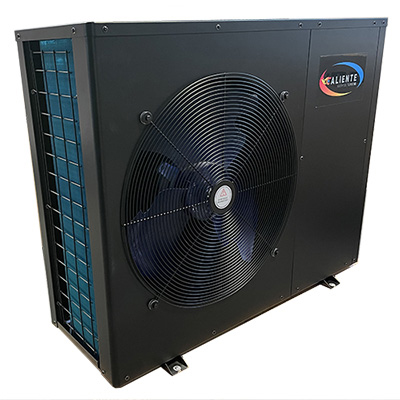Heat pumps for swimming pools
- with inverter for low consumption and quiet operation
- defrosting to operate at lower outdoor temperatures
- reversible for heating your pool or cooling it in case of extreme temperatures
- wifi connected for control via smartphone
How to Choose a Heat Pump?
The choice of a heat pump is mainly based on:
- The volume of the pool
- The delivered power of the heat pump
Manufacturers indicate the delivered power of their models based on the temperatures of the outside air and water (see performance tables).
The delivered power to be considered is the one indicated for an air temperature of 15°C, water temperature of 26°C.
The table below shows several pool dimensions, their respective volumes, and the necessary delivered power in kW:
| For pools of dimensions | 4x3m | 6x3m | 7.5x3.5m | 8x4m | 9x4.5m | 10x5m | 11x5.5m | 12x6m | _ |
| With water volume (average depth 1.5m) | 20m3 | 30m3 | 40m3 | 50m3 | 60m3 | 75m3 | 90m3 | 110m3 | 150m3 |
| Recommended power* | 5kw | 7kw | 10kw | 13kw | 17kw | 20kw | 26kw | 30kw | 34kw |
* Powers calculated by the manufacturer for an air temperature of 15°C, water temperature of 26°C, basin with a summer cover type bubble wrap.
Other parameters will also need to be considered: region and climate, electrical supply, distance between the pool and the heat pump, period of use... contact us for a personalized thermal assessment.
How Does a Heat Pump Work to Heat Your Pool?
A heat pump captures the calories present in the air and heats the water of your pool. Its operating principle is similar to that of a refrigerator by capturing the calories present in the air. While a refrigerator transfers heat outside to cool its interior, a heat pump for pools transfers the calories from the outside air to warm your pool's water.
Its operation is more economical than an electric heater of the same power. It consists of a refrigerant fluid circuit and a compressor.
The transfer of outdoor air calories to the pool water is linked to the operation of a compressor-condenser-fan-evaporator assembly and a refrigerant gas circuit, all located in your heat pump.
Principle:
1/ The compressor compresses the gas coming from the evaporator in the condenser. The gas heats up and turns into liquid. The condenser ensures the transfer of calories by thermal exchange to the pool's water circuit.
2/ The gas, still in liquid form, returns to a gaseous state in the evaporator and cools down. The fan blows the outside air (warmer) over the evaporator (cooler), ensuring the transfer of air calories to the gas circuit.
3/ The gas will be compressed again in the condenser, forming the cycle of the heat pump and heating your pool.
The operation of the compressor motor constitutes the main energy consumption, making the principle of heating by heat pump 5 times more economical than an electric resistance heater (heating by Joule effect).
How to Install and Connect a Heat Pump for a Pool?
A heat pump is installed on the filtration pump circuit of your pool, in a bypass (called "by pass") at the outlet of the filtration circuit, after the filter. Its connection must be carried out by a qualified electrician and must be protected by a 30mA differential thanks to a properly sized circuit breaker.

2. Pool Pump
3. Pool Filter
4. Suction
5. Discharge
7. Hot Air Inlet
8. Cold Air Outlet
9. Electrical Supply
Choose a heat pump compatible with the different water treatments (salt electrolysis, UV treatment, chlorine, bromine...) and other equipment.
Save Energy with a Heat Pump
Heating your pool with a heat pump is the best way to save money while optimizing your pool's temperature. Its heating principle and the heat generated by a heat pump go beyond the simple calculation of any other traditional heating method: 1kw consumed = 1kw of heating output.
Indeed, for a heat pump, 1kw consumed = up to more than 5kw of heating output. A heat pump therefore allows you to extend your swimming season and enjoy your pool for longer while saving energy.
In addition to a heat pump, we recommend installing a thermal cover to retain your pool's temperature.
How Long Does It Take for a Heat Pump to Heat a Pool to the Desired Temperature?
The heating time for an ideal temperature rise of your pool's water varies depending on different factors.
Indeed, depending on the exposure of your pool (wind, sun) and the low temperatures observed in your department, the protection your pool has, or the type of pool to be heated (in-ground, above-ground) and whether it's an overflow pool or not, the time it takes for your heat pump to heat can vary considerably.
Keep in mind that at night, your pool can lose an average of 4°C to 5°C and that an ideally sized heat pump heats the water on average by 1°C to 3°C per day. Therefore, it is preferable to protect your pool to maintain as accurately as possible the temperature increase operated by your heat pump. The use of a bubble cover, a pool shelter or even a shutter can help reduce heat loss and thus help you heat your pool more quickly
By using a cover, you limit heat loss and thus only lose an average of 1°C to 2°C during the night!
The Different Features of a Heat Pump
Because it's important to understand the different features available depending on the models of heat pumps, below is a complete detail of existing functionalities.
Reversible: A heat pump with the reversible function allows you to heat or cool the water of your pool depending on the season.
Inverter: A smart Inverter heat pump adapts its consumption based on the difference between the water temperature and the desired temperature, thus adjusting its regime.
On / Off: Unlike an Inverter model, an On / Off heat pump, once running, will operate at full capacity. It does not adapt to the temperature, the heat pump will be turned on or off.
Defrosting: The defrosting function allows a heat pump to defrost automatically in case of severe negative temperatures by reversing the direction of gas and air circulation to proceed with the defrosting of the device.
What is the Coefficient of Performance (C.O.P)?
The COP, or Coefficient of Performance, represents the energy efficiency of the heat pump operating in heating mode. It corresponds to the ratio between the useful energy (heat output for heating) and the energy consumed to operate the heat pump.
Example: a heat pump with a COP of 5 consumes 1 KW of electricity to deliver 5 KW of heat. This device produces 5 times more energy than it consumes.
The higher the COP, the more efficient the machine and the more your electricity bill will be reduced.
Properly Sizing Your Heat Pump
Because it's essential to choose the right size of your heat pump based on your needs, we offer heat pumps adapted to the volume of your pool for daily water heating assistance.
For tailored sizing and personalized advice, our advisors are at your service.
Consult our advisors at 0800 800 099 for your free and personalized estimate
Heat Pump for Small Pools, Mini Pools, and Above Ground Pools
Our selection of heat pumps is suitable for all types of pools, so you will find heat pumps for small pools with a volume less than 30 m3. You can thus heat the water of your small pool with a suitable heat pump, which is quiet and has the ideal power to extend your swimming season in your mini pool.
Where to Install Your Heat Pump?
[/p]You can install your heat pump anywhere. However, there are various elements to consider in its installation.
For optimal efficiency of your heat pump and the temperature rise of your pool, we advise you, if possible, not to place your heating equipment facing North due to potentially longer defrosting cycles. Also, placing your heat pump within 7 meters of your technical room will avoid any heat loss.
Remember to position your heat pump so that there are no obstacles within 2 to 5 meters and of course at least 50cm from all walls and at least between 2 and 5 meters from your pool (standard C 15100).
In the case of installation in a windy region, it is preferable to avoid installation facing the wind to prevent resistance on the blades that could damage the motor during operation.
Placing your heat pump too close to the edge of a roof is not recommended due to the risk of snow or ice falling during winter.
How does a heat pump work?
A heat pump collects calories present in the ambient air to heat your pool by transforming them into heat diffused into the pool water by a thermal exchange.
A heat pump works using the same principle as a fridge but inversed. A fridge transfers heat to the exterior to cool its inside temperature. A heat pump transfers calories present in the ambient air to heat your pool water.
A heat pump is composed of a compressor, exchanger, condenser and ventilator. It uses cooling gas to operate.
Heat pumps are easily installed in your pool, the hydraulic connection is put into use by a by-pass the outlet of the pools filtration system.
You can heat your pool water at a very competitive cost of approximately 2 Euros a day for 50 m3 pool.
Advantages
- Ecological, environmentally friendly.
- Energy savings
- High performance, consuming 1kw for 5kw produced
- Easy installation
Schema depicting the connection to your pools hydraulic system

2. Pool pump
3. Pool filter
4. Suction
5. Discharge
7. Inlet hot air
8. Outlet cold air
9. Power supply
Our team is here to advise you concerning all relevant questions for your heat pump installation.
Ask for a free quote heat pumps for swimming pools
Other product : Heat pumps for swimming pools
Starting from 790 eur Including VAT.
Please fill in this form carefully. Our commercial service will handle your request promptly.
UK freephone hotline
Monday Friday 9.00 18.00

Spare parts order
You are looking for a spare part for «Heat pumps for swimming pools» ?
Please click the button below. Our commercial service will handle your request promptly.





